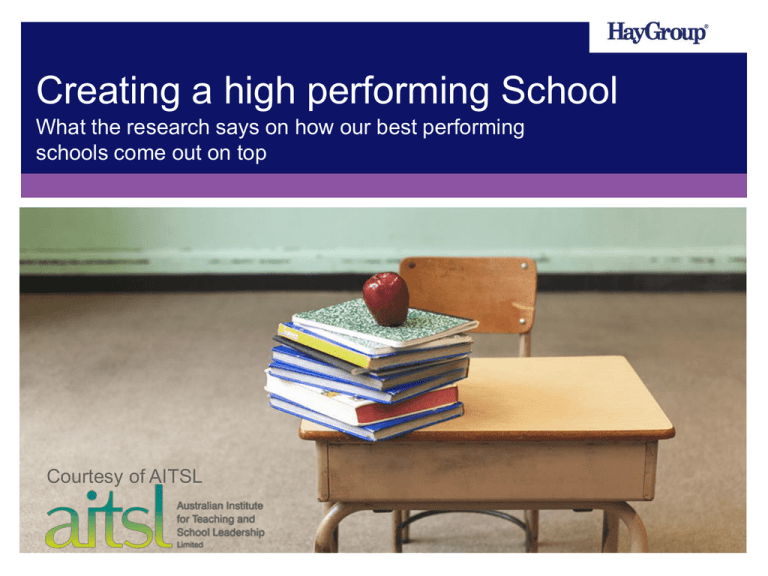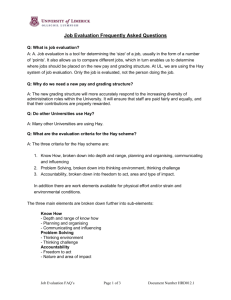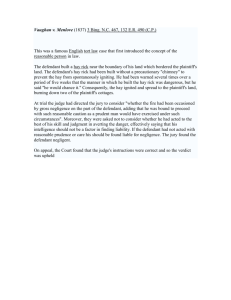
Creating a high performing School
What the research says on how our best performing
schools come out on top
Courtesy of AITSL
Some common data
In all schools, relatively high levels of literacy, numeracy
and VCE outcomes are paralleled by:
Low
absenteeism
High staff opinion, especially of student motivation
High student opinion of teaching and learning variables
Relatively high real retention in the secondary colleges
© 2010 Hay Group. All rights reserved
2
What we found - common themes
Each case study is unique — reflective of local
circumstances and strategic responses
Each case study had lots of replicable strategies and ideas
A set of common themes supported by educational
research
© 2010 Hay Group. All rights reserved
3
What we found – 10 lessons
1. Strong leadership that is shared, stable, strategic and
sustained over time
2. High levels of expectation and teacher efficacy
3. Ensuring an orderly but supportive learning environment
4. A focus on what matters most
5. Building teaching and leadership expertise
6. Structured teaching to ensure all students succeed
7. Using data to drive improvement
8. A staff culture of sharing and responsibility
9. Initiatives tailored to the direction of the school
10. Engender pride in the school
© 2010 Hay Group. All rights reserved
4
10 Lessons — Two sorts
10 lessons were identified which identify the key success
factors; but these lessons, which inevitably overlap, were of
two different sorts
Those
which constitute preconditions for substantial
improvement
Those which enable the schools to sustain improvement
over time
© 2010 Hay Group. All rights reserved
5
Preconditions for improvement
Strategies which must be in place for improvement to take
hold
Generally the starting point for improvement efforts in the
schools
Where they do not exist, they may require external
intervention or support
© 2010 Hay Group. All rights reserved
6
Lesson 1
Precondition 1
Strong leadership that is shared, stable, strategic and sustained
over time
‘I know of no improving school that doesn’t have a principal who is
good at leading improvement’ — Michael Fullan
The precondition of the preconditions
© 2010 Hay Group. All rights reserved
7
Lesson 1
Precondition 1
Strong leadership that is shared, stable and sustained
over time
Leadership with a clear vision and direction for the school with a
capacity to influence others – strong purpose sustained over time
Leadership is developed, shared and spread through the school.
Principal as the leader of leaders.
The leadership is highly strategic – relentless but realistic
Though teaching is the key, leaders establish the conditions for high
quality teaching
© 2010 Hay Group. All rights reserved
8
Lesson 2
Precondition 2
High levels of expectation and teacher efficacy
High expectations — challenge the argument ‘you cannot expect more
from these kids’
Higher aims and targets than matching equivalent schools
High expectations for students flows through to staff and promotion of
teacher efficacy — we can make a difference for the students we
teach
Linked to leaders expectations of teachers and teachers expectations
of each other – high level of internal accountability.
© 2010 Hay Group. All rights reserved
9
Lesson 3
Precondition 3
Ensuring an orderly learning environment where every
student is well known
A fundamental precondition for improved teaching and learning, and
subsequent improvement in student outcomes
The starting point for improvement in each case
A key mechanism for getting teacher consistency
The basis for further united action in the school
The mirror image of the situation in under-performing schools
© 2010 Hay Group. All rights reserved
10
Lesson 4
Precondition 4
A focus on what matters most
Relatively few priorities focused on core things students need
A clear sense of how to prioritise and put first things first (in the context
of the school)
Reflects the importance of leadership (strategic leadership)
Importance of difference with school effectiveness models – it does
matter what you do first.
© 2010 Hay Group. All rights reserved
11
Some quick wins from these
schools
The orderly learning environment in every case
(uniform, punctuality, etc.) and school appearance
The
observation room
Work Ethic Committee
Underpins relentless implementation
© 2010 Hay Group. All rights reserved
12
Sustaining improvement
Six key interrelated strategies that:
Build
on the preconditions for improvement
Sustain
ongoing improvement momentum beyond the initial
successes achieved
© 2010 Hay Group. All rights reserved
13
Lesson 5
Lesson 5
Building teaching and leadership expertise
Work to build teacher capacity around the core priorities
Develop leadership skills, especially of middle level leaders
responsible for leading a variety of areas and PLTs
Recruit expertise where needed and utilise the full range of capacities
already in place
Expect that expertise is used to best effect and develop a process for
giving feedback on performance
© 2010 Hay Group. All rights reserved
14
Lesson 6
Lesson 6
Structure teaching to ensure all students succeed
All of the schools adopt a structured approach to teaching
They work to improve their understanding of teaching strategies that
work and demonstrate a relatively sophisticated understanding of how
students learn
Structured and explicit teaching approaches are supported by
assessment regimes that ensure students are well known and their
needs are being met
Puts a premium on instructional leadership
© 2010 Hay Group. All rights reserved
15
Lesson 7
Lesson 7
Using data to drive improvement
Sharing and using data to analyse school and student performance and then
drive improvement
Supplement the rich array of required data with additional sources of evidence
to provide a comprehensive picture of student performance and individual
student needs
Using data to shift the focus from inference to evidence
© 2010 Hay Group. All rights reserved
16
Lesson 8
Lesson 8
A culture of sharing and responsibility
High levels of staff collegiality and mutual support, with structures in
place to help teachers share and learn
Active PLTs and an expectation that teaching and learning programs
are documented and shared
The high degree of sharing provides a means of turning individual into
collective teacher efficacy.
© 2010 Hay Group. All rights reserved
17
Lesson 9
Lesson 9
Tailoring initiatives to the direction of the school
The schools all ensure that broader systemic or government initiatives
are integrated with the overall directions and priorities that are set.
(e.g. Performance & development culture)
Principals as ‘meaning makers’ or ‘coherence makers’
The most valued initiatives in this context are those which reinforce the
direction the school was headed, but add some extra impetus and
rigour
© 2010 Hay Group. All rights reserved
18
Lesson 10
Lesson 10
Engender pride in the school
All take pride in their buildings and grounds as well as the work the
students produce
This reflects a general expectation that everything is of high quality in
the school
© 2010 Hay Group. All rights reserved
19
Conclusion
Many of the lessons are no surprise and reflect the findings of
research
Their value really comes through identifying a distinction between
preconditions for improvement and other factors related to sustaining
momentum. This has implications for how schools might approach
improvement
The successes of these schools were not achieved overnight. A stable
and consistent leadership team worked on their strategic approach for
a significant number of years
© 2010 Hay Group. All rights reserved
20






